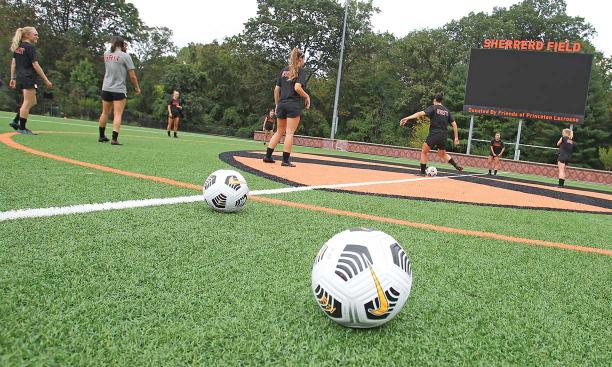
So thrilled were the Princeton women’s soccer players to be back on the field this fall, coach Sean Driscoll was afraid they’d burn themselves out at their first game — against Loyola — at the end of August.
“There’s an energy and enthusiasm that will probably push these kids to greater strains on their bodies,” Driscoll said in early August. “So managing their minutes, managing fatigue, managing the mental piece of it and the physical piece is essential.”
No Princeton fall teams have competed since November 2019 due to the COVID-19 pandemic, but now, they’re back. Field hockey was scheduled to be among the first to play in early September, in a daunting game against North Carolina, which was fresh from winning the national championship in May. Princeton field hockey does not have a senior on its roster, and like all fall Princeton teams, its freshman and sophomore classes have yet to play in college.
“A big issue that we’re going to have here is onboarding all those people and getting everyone caught up to speed,” said field hockey coach Carla Tagliente. “Having about half of our team having zero college-game experience is going to be interesting.”
Men’s soccer was set to play Rutgers that same night. The team held spring workouts with only a dozen of the 32 players rostered this year, and head coach Jim Barlow ’91 feels a bit like he’s starting from scratch.
“We’re trying to learn an awful lot in a very short period of time,” he said. “Hopefully it’ll feel like a normal preseason once we’re back.”
The football team won’t kick off games until Sept. 18 at Lehigh. Head coach Bob Surace ’90 feels better prepared for the fall after loosened NCAA rules allowed a more productive spring for the 53 players available to work out. More joined them over the summer, including some older students who took a year off during the pandemic to preserve a year of eligibility at Princeton.
“I think we are at least in a normal getting-ready-to-start path,” Surace said. “We’re doing it with an extra group of guys that are leaders and were here for three seasons.”
Returning gap-year players are making all of Princeton’s fall teams larger, complicating the task of building cohesiveness. Another hurdle is that Ivy preseasons already are shorter than their nonconference opponents’, and now under a new academic calendar, Princeton classes began Sept. 1, 10 days earlier than in 2019.
Coaches say the early returns from this year’s virtual recruiting are promising. They feel even better connected to their recruits after spending so much time communicating with them, not just watching games. Driscoll said it helped that over Zoom, he was able to have face-to-face conversations with students and parents. “It has revolutionized recruiting,” he said.
This fall presents a chance to see how these new recruits fit into their respective teams. “It’s going to be an interesting season, no matter what happens,” Driscoll said. “But I’m really happy these kids — fingers crossed — will get a chance to go play again, because they deserve it.”
